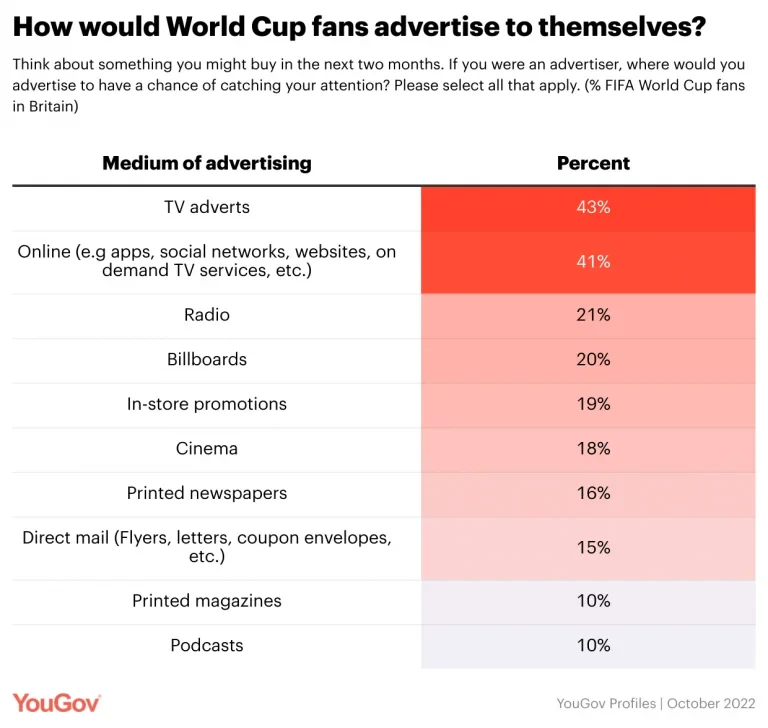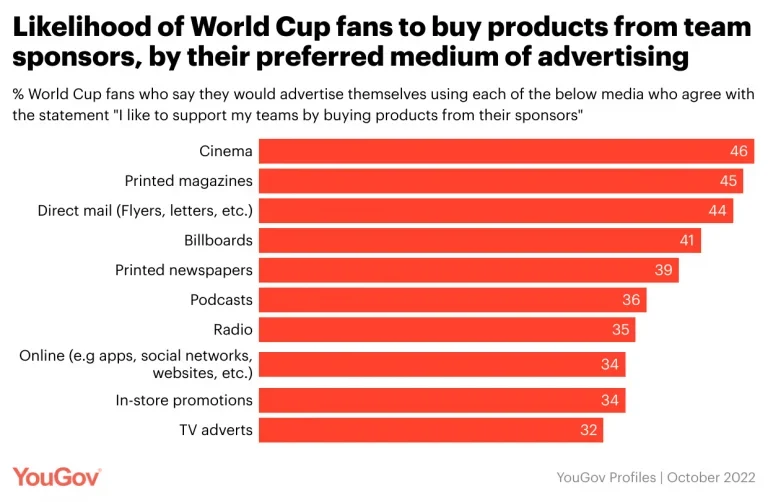
What types of sponsorship do World Cup fans notice?
As the FIFA World Cup draws closer, we look at the types of sponsorship that appeal to World Cup fans in Britain.
As established in this article, the FIFA World Cup is the most popular single-sport sporting event around the globe, and thus represents a great opportunity for brands to reach a global audience. As the Qatar World Cup 2022 draws closer, we explore the types of sponsorship that World Cup fans are most likely to take note of, focussing on audiences in Britain.
This data is based on a YouGov Profiles variable which asks consumers about the medium they would use to advertise to themselves for a product they are likely to purchase in the next two months. This piece looks exclusively at FIFA World Cup fans – defined as Brits who say they are “somewhat interested” in the FIFA World Cup or that it is one of their “top interests”.
Over two-fifths of these World Cup fans say they would advertise to themselves via TV adverts (43%), making it the most popular advertising medium. But a similar proportion would also advertise to themselves via online mediums such as social media, apps, websites, or on-demand TV services (41%).

A fifth of World Cup fans would use radio (21%) or billboard adverts (20%) as a means of advertising to grab their own attention. In-store promotions (19%) and cinema ads (18%) could also have a sizeable portion of takers. One in seven consumers say they would use printed newspapers (16%) and direct mail flyers (15%) as a means to effectively advertise to themselves. A tenth of these World Cup fans are also likely to pay attention to adverts on podcasts (10%) and in printed magazines (10%).
But not all sponsorship mediums are equal as some may have a better chance of converting impressions into sales. YouGov Profiles also tracks consumer attitudes on whether or not they would be likely to purchase from sponsors of their favourite sports team. Filtering that data by their preferred method of advertising to themselves reveals some noteworthy variances.
A third of FIFA Men’s World Cup fans who would advertise to themselves via TV or online mediums agree with the statement “I like to support my teams by buying products from their sponsors”. This share rises significantly among those fans who would advertise to themselves using printed magazines (45%), cinema (46%) and direct mail (44%).

Which types of sponsorship have World Cup fans taken note of in the past six weeks?
While examining the mediums of preferred advertising that consumers would use to advertise to themselves can be instructive, it is also worth taking a look at the types of sponsorship they have noticed in the recent past.
Nearly half of those interested in the World Cup say they noticed a sponsor of a TV programme (46%) in the last six months. A similar proportion of consumers said they noticed a sponsor of an event such as a sporting event or musical concert (45%).
More than two-thirds of these World Cup fans took note of the sponsor of a sports team (36%) or of a brand seen in a film or TV show through product placement (35%).
A fifth of fans also pay attention to sponsors of user-generated content on platforms like YouTube or on podcasts (21%), and a similar proportion of them have taken note of venue sponsors (20%). One in seven FIFA Men’s World Cup fans have noticed sponsors of social media posts (15%) and a tenth have taken notice of brands that are part of co-branding partnerships (10%).